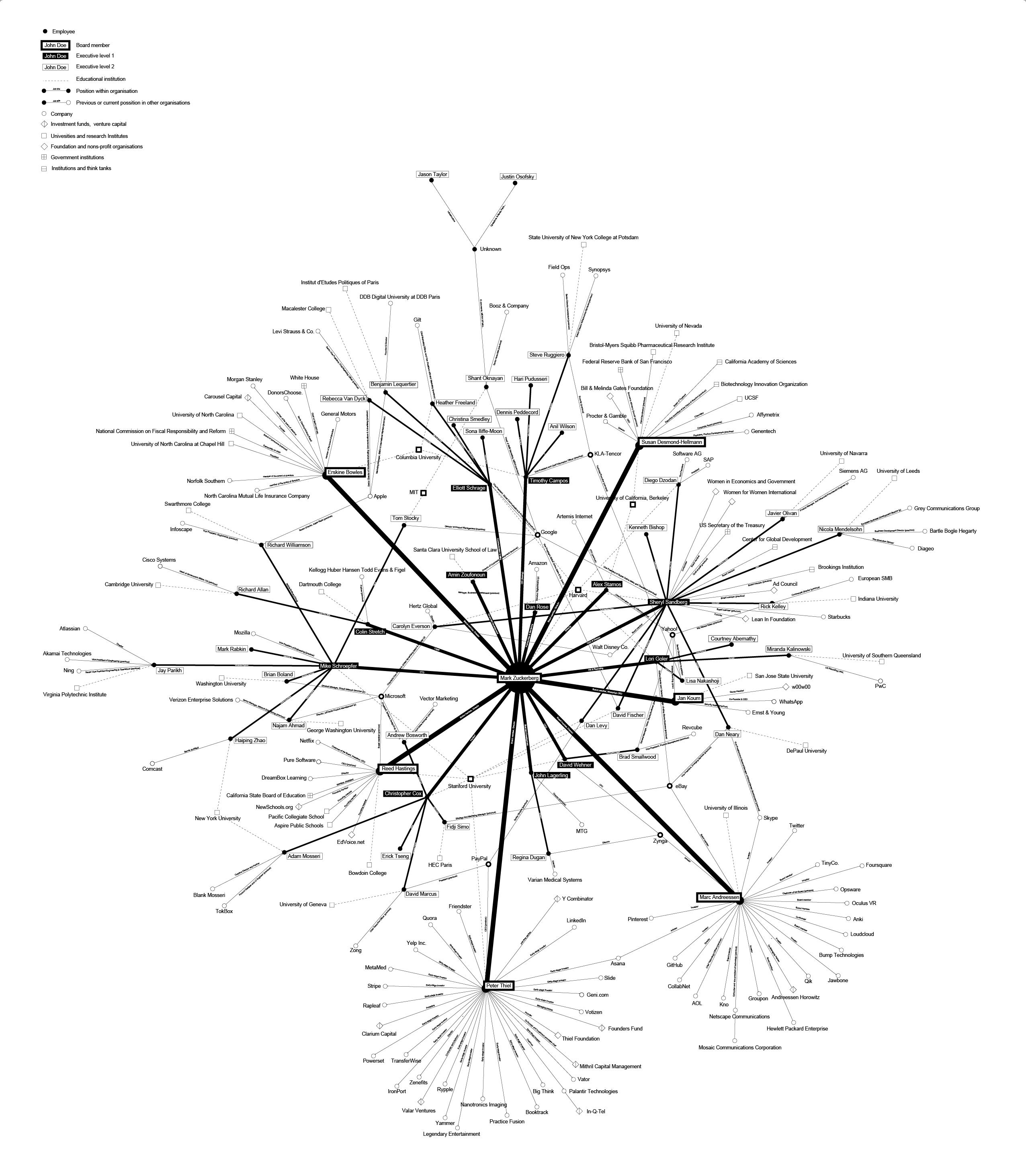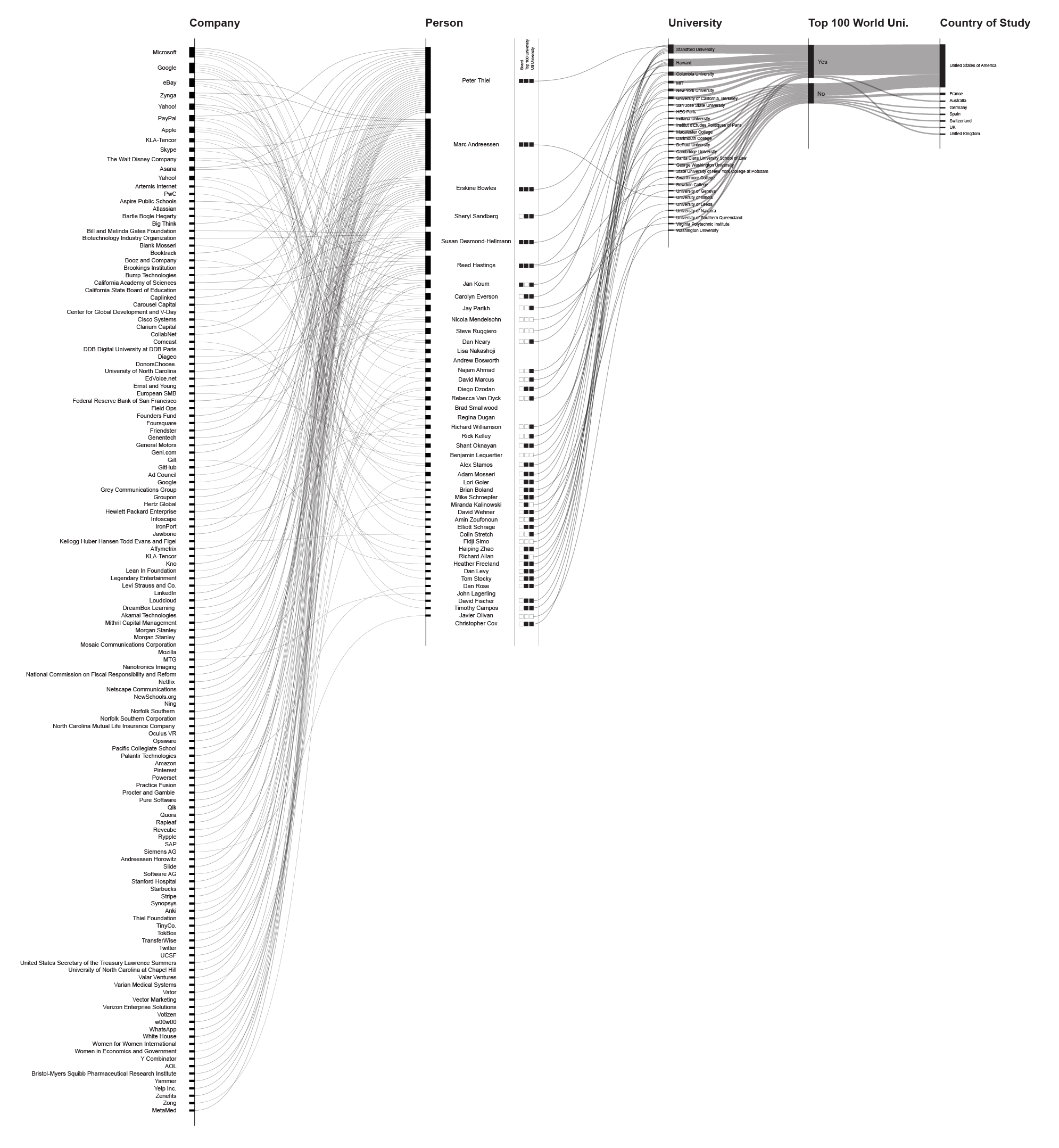
n our previous research, we investigated different areas of the Facebook dispositif:[1] algorithmic and human labor, the digital infrastructure behind the social network, and the exploitation of personal information.
In this article, we will try to map some elements of Facebook’s human fabric, the social structure and the power relations within the company.
We will investigate and reflect upon the phenomenon of Facebook in terms of the social networks of its employees. We will also consider the social relations between the members of Facebook’s management board and other spheres of society. This article is a contribution to the contemporary critique of the strong ties between political establishments and global business, i.e. that of the issue of the revolving door.[2] In short, we will deal with the phenomenon of digital capitalism.
Knowledge Labour Aristocracy
We want to learn more about the personalities, their embeddedness into classes and their networks within and outside the closed society of the Facebook corporation; we want to find out how these classes are structured, to know more about the people these classes consist of, how they move or migrate around the world. We are also interested in understanding of roles of all the persons around Mark Zuckerberg who rule or serve this corporation. While asking ourselves about the people who build the Facebook pyramid, we have in mind the notion of class determinism and the idea that the classes reproduce themselves and create the environment in which its members will be able to function optimally. Bourdieu’s notions of social space, habitus, the cultural, educational/informational, and social capital (Bourdieu 1982, 1997) were present in our reflections before and during the research. The mentioned terms introduce Marx’ idea of capital accumulation which shouldn’t be forgotten when thinking about the Facebook collective or any other representative of digital capitalism.
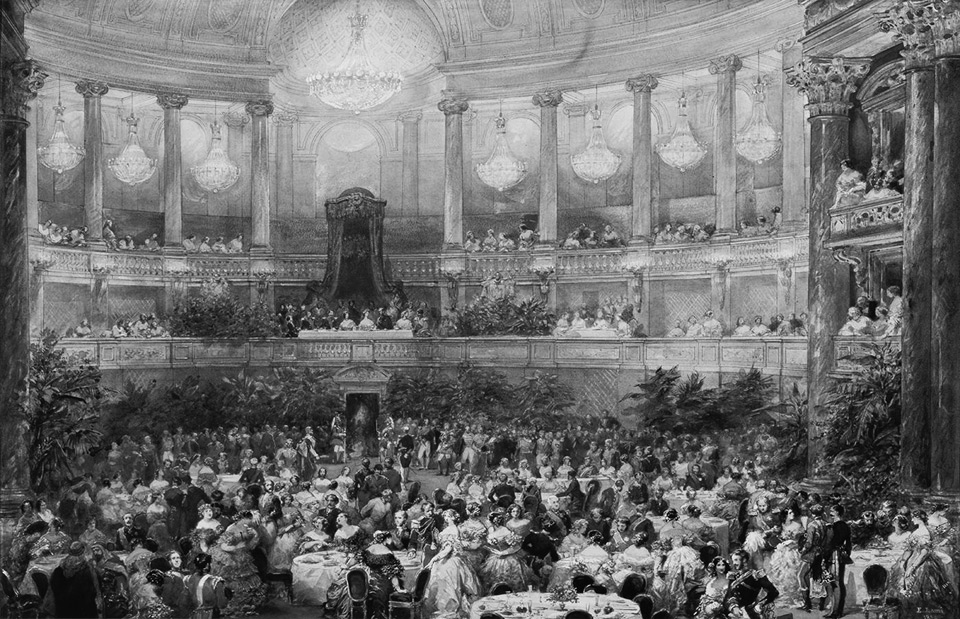 Figure 1: Dinner in the salle des spectacles at Versailles – Eugene Louis Lami
Figure 1: Dinner in the salle des spectacles at Versailles – Eugene Louis Lami
Source : Wikigallery.org
We can think about almost any class of the Facebook employees as a perfect example of highly paid knowledge labour aristocracy.[7] This model is the opposite example to other forms of labour hidden behind the surface of IT industry, “such as slave-labour extracting minerals, the labour of militarily controlled and highly exploited hardware assemblers, precarious digital service workers, imperialistically exploited knowledge workers in developing countries, workers conducting the industrial recycling and management of e-waste, or highly hazardous informal physical e-waste labour” (Fuchs 2016: 61). On the top of this pyramid of knowledge labour, we see the small circle of ‘silicon sultans’, network of individuals who control or have significant influence on the biggest companies in the field, sit in their boards or own parts of their shares.
 Figure 2: Robber Barons
Figure 2: Robber Barons
Source : Robber Baron or Captain of Industry….What does that mean? (video)
The original accumulation of the capital in the United States shows some intriguing similarities with the oligarchy from the Silicon Valley.[8] The second half of the 19th century was marked by the creation of the infrastructure (railroads) for the American single market, and by the transition to industrial society, bringing innovative products to the doorsteps. The American ‘robber barons’ of the 19th century amassed huge wealth by squeezing out the competition, much like today’s ‘silicon sultans’. An illustrative comparison will show us: “Rockefeller once controlled 80% of the world’s supply of oil; today Google has 90% of the search market in Europe and 67% in the United States while Facebook has 42% of the social media market share in US only” (Economist 2014). Similarities between these two groups of infrastructure pioneers lead to a warning conclusion: the characters spearheading the transformation of an industrial age into an information society on a global scale “stand accused of being greedy business folk who suborn politicians, employ sweatshop labour, stiff other shareholders and, especially, monopolise markets” (Economist 2014). Once regarded as ‘inventive mould-breakers’, silicon sultans now digress into solving mankind’s problems, from ageing to space travel, grounding their entitlement in the data industry the world became dependant on.

On Top of the Pyramid: the Board and the Management
In order to visualise the connections of Facebook’s (FB) management,[9] i.e. its board of directors and advisors, and two executive levels, we used publicly available information provided by the Official Board and Crunchbase websites.[10] For every person on these lists we analysed educational and professional background as presented in his or her official biography. It should be borne in mind that all of these people are in the public eye and that their biographies are not secret. Thus, all of the given information is available to everyone who wishes to find it, and our use of it is not a result of any illegal or covert activity.
The following network should help us deepen the understanding of the connections within the board itself and the ties between the Facebook and the industry, the ties of Facebook and the government, and the ties of Facebook with civic organisations (such as e.g. think-tanks).
Figure 3: Facebook Management Graph – PDF Version
In the centre of the graph is Mark Zuckerberg, surrounded by the board members. As shown in the upper left corner, the yellow rectangle marks board members, the black rectangle marks the first level of executives, and the white rectangle the second level of executives. The networks surrounding these actors connect the educational institution from which they obtained their degree, their position within Facebook, and/or ties to a previous position in a respective organisation. The organisations can be of different types as mentioned above: company; investment fund or venture capital; university and/or research institute; foundations and non-profit organisations; government institutions; and non-governmental institutions such as think-tanks. Each of the actors is connected with several organisations in different ways.
Here are few examples of how you can read this map:
Ties to Politics and Parties
The member of the board Erskine Bowles, (upper left corner) from the inner circle around Mark Zuckerberg, has been also Chief of Staff in the White House, and is the co-chair at the National Commission of Fiscal Responsibility and Reform, a governmental body that he himself helped to establish in 2010.[15] His ties to the financial industry through his work experience in Morgan Stanley,[16] and in the technological industry through General Motors[17] show the kind of systemic support that Facebook can rely on through the members of its board. Erskine Bowles stands for the connection of the financial, technological and IT industry with the politics and with the Democratic Party. Even if it is not so easy to talk about the protectionism in the classic meaning of the word, these connections do show the common interest of the actors within the political administration with those of the private business.
This kind of political engagement in the context of mentioned lucrative businesses is problematic from the standpoint of European public and political tradition. From the perspective of civil rights and privacy policy, the strong institutional connections between the governmental bodies, secret services and social networks, i.e., communication infrastructure can only be seen critically. Mentioned examples show how elites merge with political establishment to concentrate power. We remind readers, however, that this phenomenon is generally not seen as something wrong in the U.S. since all these people are publically talking about these achievements as something highly positive. At the same time, similar ties are to be found in other branches of industry and in other countries. By no means advocating it, we think that the global success of a company like Facebook would not be possible without these kinds of capacities.
Google’s kiss to Facebook
As we will see further in this paper, among the transferred professionals working for Facebook, the number of former employees from Google is the highest. Regarding the managing class of Facebook, we can see that the Google node (in the centre, above Zuckerberg) on the graph is also important since it connects several important actors. Shant Oknayan from UAE is responsible for the Middle East and North Africa (MENA) region in the E-commerce, Retail, Online Services and Media. He, however, came from the similar post at Google. Tom Stocky, director of Search department, used to be Director of Product Management at Google. David Fischer and previously mentioned Sheryl Sandberg both used to be vice presidents of Global Online Sales and Operations at Google. A similar situation emerges when it comes to the Microsoft or the Apple nod at this map. According to the graph, in case of the higher management, most of them already had experience of working for some of the top companies in the field. This fact supports the idea that the higher strata of new knowledge labour aristocracy is already defined and is only rarely pulled up from the lower strata.
***
Management ties and education
The following graph is based on the same set of data but visualised in form of the alluvial diagram. It can help us to get a better insight into the educational background of Facebook’s top management and board members.
Figure 4: Facebook Management. Ties and Education
It is interesting to notice that people from the managing class of Facebook are not only from the Ivy League universities. They do come mostly from the best ranked U.S. or the best ranked world universities – most of them have been studying at Stanford, Harvard, or Columbia University. However, this is not the criterion for any of them to be at the position they are now. In so far, it could be possible to talk about social mobility concerning the lack of connection between the rise in the company and the educational background. One example is Jan Koum who could be seen as an outsider with his background at San Jose State University, but shows that his experience with Yahoo and Ernest&Young fits the profile of an average Facebook board member – and is benevolent in his own project WhatsApp.[18]
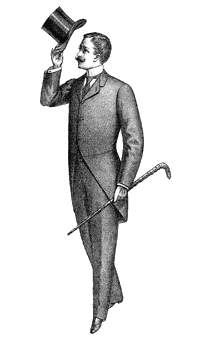

Within the Pyramid: The Adventurous Journey of the Lower Knowledge Strata into Labour Aristocracy
As mentioned above, in order to learn more about the Facebook employees, we were using publicly accessible data from the LinkedIn network. We used modification of Littlefork[19] which scraped the profiles of 1000 people stating in their professional activities that they are or have been working for Facebook. We believe these data are useful only to a certain extent since there is no way of checking their complete accuracy. The total number of Facebook employees in 2015 according to 10-K form was 12,691[20]. We think that for the ethical reasons and social responsibility Facebook should represent in its employee and managerial structure the gender, culture and race of its global market and not only the U.S. American one. The results of our research show that Facebook represents (significant parts of) U.S. political, social, and economic elites instead.
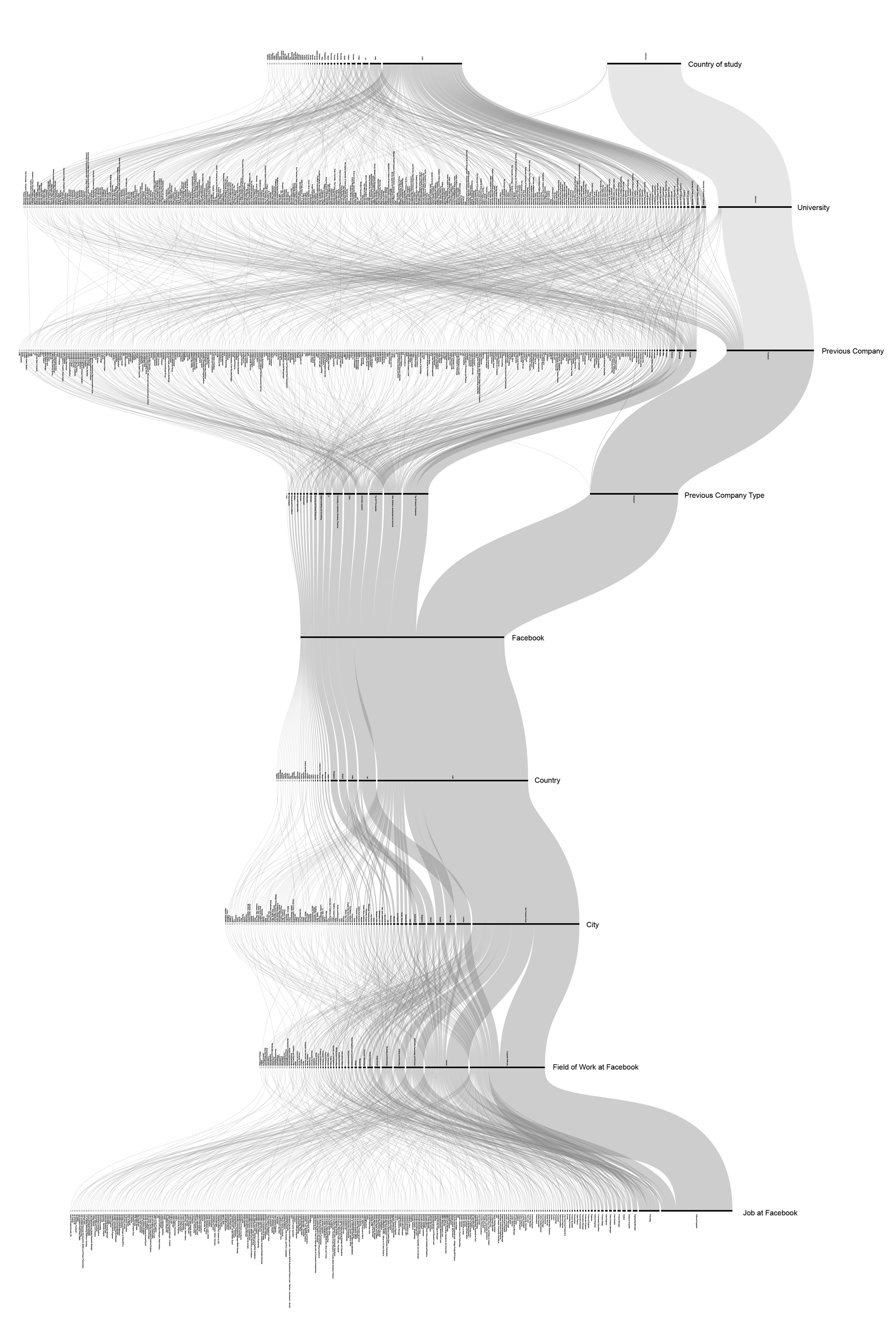 Figure 5 : Educational and Professional Development of Facebook Employees – PDF Version
Figure 5 : Educational and Professional Development of Facebook Employees – PDF Version
Figure 5 shows the professional and educational background of Facebook employees (it does not say anything about the managers and executives). It should be read from the top to the bottom as follows: the country of study on top is the country where the person employed studied, whereas the following category shows the university stated in their LinkedIn biographies. Below that we can see the job position before joining Facebook. The highest number of employees started to work for Facebook right after their studies and majority of them originates from the U.S.A. In other words, only a very small percentage of FB-employees, who began to work for the company immediately after their studies, came from educational institutions outside the U.S.A.
***
***
After joining Facebook, some employees get relocated. Most of them stay within or move to the U.S.A. However, the number of people working in the U.S.A or moving there is by far larger than the number of Facebook employees anywhere else in the world. The next country with a significant number of Facebook employees is the United Kingdom, followed by India and Ireland. Approximately the same number of employees are located in India, Ireland, and Singapore. The next countries on the list are Japan, Romania, Brazil, and the United Arab Emirates, but these cannot compare in terms of numbers of employees with the places mentioned before. When we talk about urban centres, the largest number of people working for Facebook is located in the San Francisco area. The second-largest city of importance for Facebook is, however, not in the U.S.A. but in the U.K. – London. We see the reason for this large difference in the numbers in the inconsistency and unreliability of the data for the fine-grained personal information such as place of living. One of the facts that confirms problems with the data set is that among the urban centres we also find countries such as Singapore or Ireland. For the same reason, we believe some other cities in the U.S.A. are therefore not represented on this list.
***
Concerning the field of professional activities, the vast majority of the people stated on their accounts that they are working with computer software. The other groups further below are called Internet, Information technology and services, Staffing and Recruiting, Marketing and Advertising. These are problematic and could be regrouped to build larger fields since it seems that at least some of them share the same activity. On the bottom of this graph we see the job list as stated on the LinkedIn profiles. The largest group belongs as expected to Software Engineers. The second largest group goes to Recruiting (HR). Finally, a number of smaller professions are stated (such as Engineering Manager, Research Scientist, Product Manager etc.) which also can be regrouped in larger fields or be to some extent added to the largest group. We don’t doubt the validity of the data for the largest groups and find it plausible that the recruitment takes such an important place for the company. We can conclude from these proportions that the selection process it one of the most important activities in the company’s work (facilitating internal value), and that the engineering field is the most valued one for the company (facilitating products). These relations should be kept in mind while reading the following chapter.
***
Positions at Facebook: Education Profiles and Distribution
The following network and table figures are based on the same database (1000 Linkedin accounts), however, combined with the data about the board members and top management. They show us the institutional and educational background of specific positions and of the members of the management.
Figure 6: Facebook Labour Network Graph – PDF Version
The kinds of nodes are defined as follows (see the upper left corner): white circles mark positions at the company, yellow circles mark board member and the first level executive, and the universities are marked by rectangles.
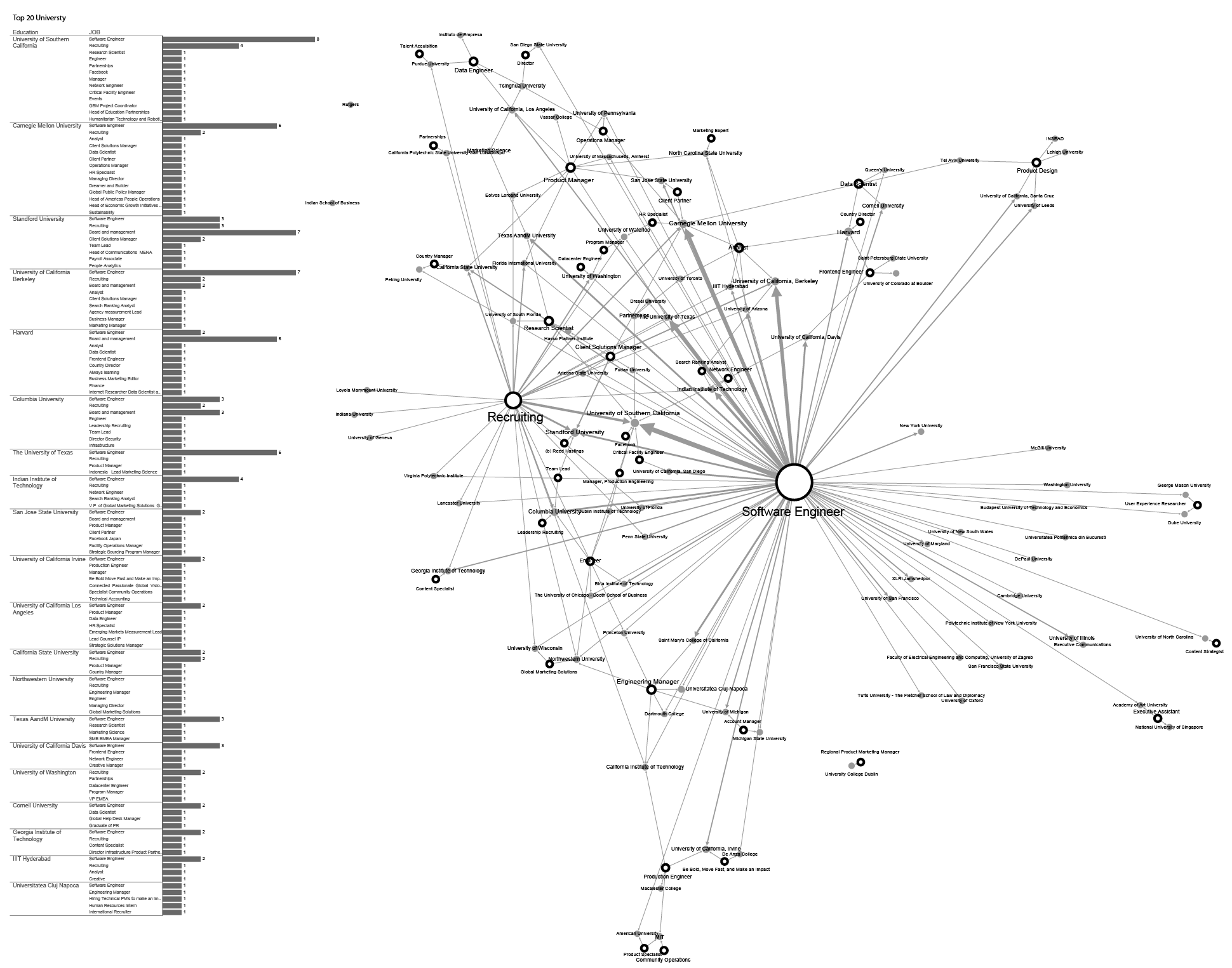
Figure 7: University Background and Position at Facebook
This network and the figure 7 show us even more precisely which job titles and professions are tied to which university. In the table on the left-hand side you can see universities ranked according to how many Facebook employees studied there.
***
Ties and Cuffs
Figure 8 shows previous ties of the board members with significant number of employees who come from the specific company to Facebook. We were interested if we can confirm the tendency that board members bring their colleagues to the new job or at least support this kind of relocation among the companies they themselves are/were connected with.
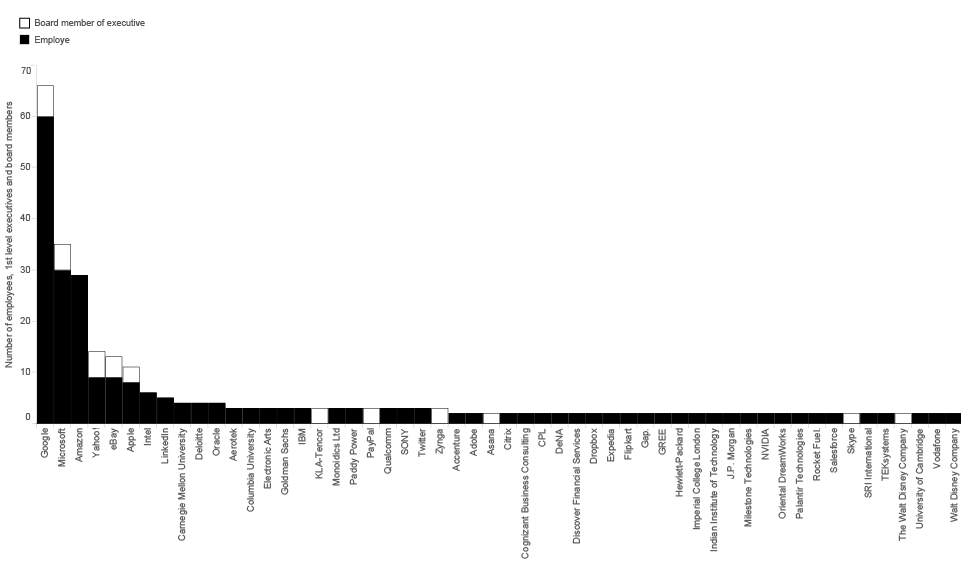 Figure 8: Previous ties
Figure 8: Previous ties
As expected, the largest number of professionals comes from the companies such as Google, Microsoft, Amazon, Yahoo, eBay, and Apple. However, there is significant difference between the ties of Google and Facebook, and all the others. We believe that in spite of all the legal measures against such actions, this graph shows cooperation in competition. Based on the percentage of people circulating among these companies and the positions and professional background of the same employees, this graph makes visible to which extent knowledge and technology exchange takes place between these entities. Such systemic ties could also be seen as building of cartel or some kind of trust which destroys the “industry ecosystem” by the means of controlled monopoly. It is hard to believe in real competition, if the competing companies share the knowledge base, experts and boards. Of course, the public data we are operating with can only indicate the possibility of the problem, they do not serve as the evidence of any kind.
***
Migration of labour: Agglomerations vs. Deserts
We already described some of the relocation processes among the FB employees around the world. On our Migration of Labour chart, it is possible to see the relation between the current country (horizontal, above) and the country of study (vertical, on the left side) of the 1000 evaluated profiles from the LinkedIn.
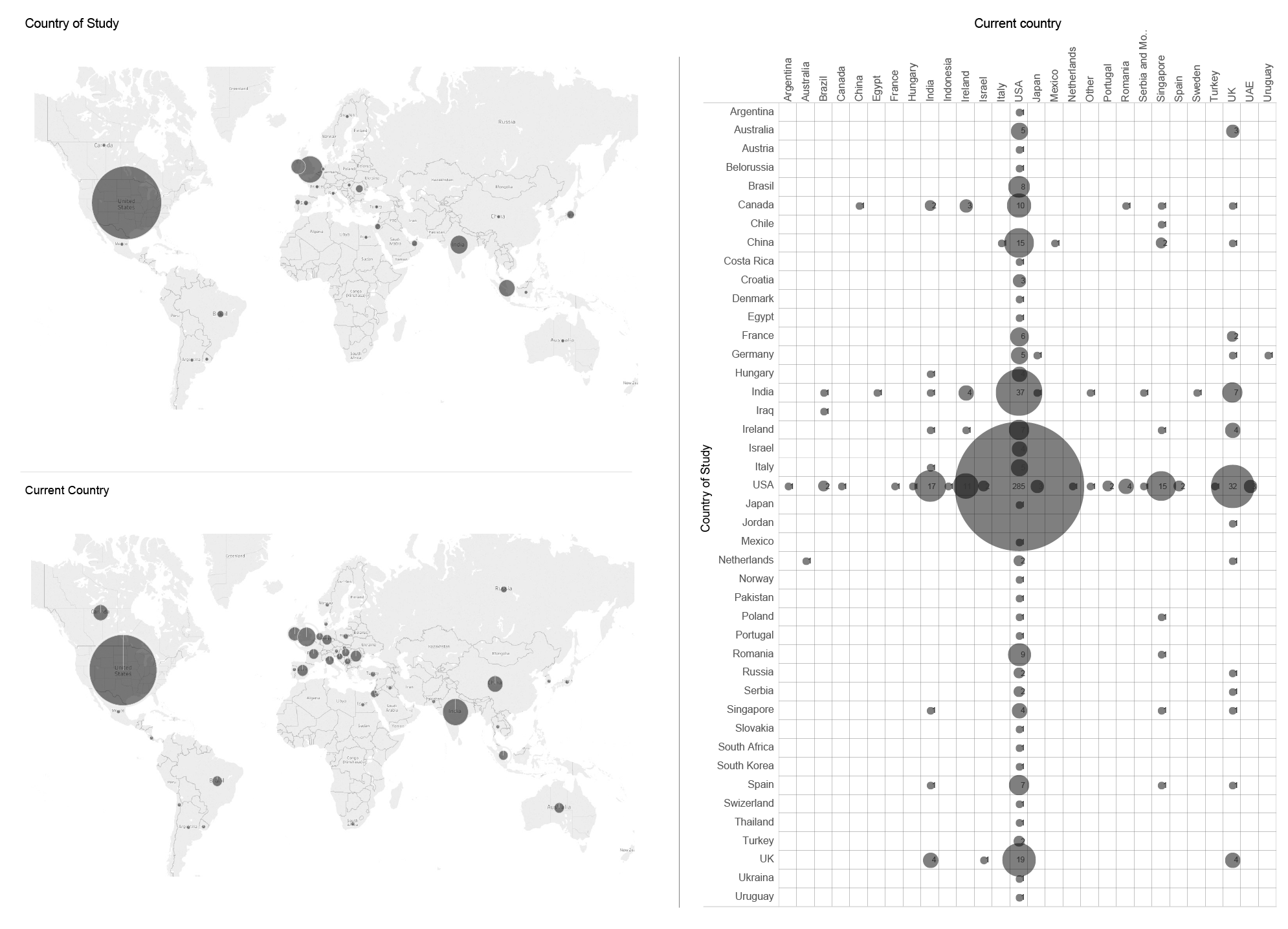
Figure 9: Migration of Labour
The same data can be visualized in a form of the maps, where current location and country of study of the employees is represented by the dark grey colour.
The Human Fabric of the Web
Sketching out the the social structure of a large company such as Facebook is a task which is important not only in order to understand the impact of such a global internet phenomenon as the social network on the society, local and global economy, and civil freedoms, but also to better understand how the development of high-end technology and communication infrastructures intertwine with the accumulation of capital and political power. Even though the world is at the point of postglobal development (a point where global is already reached and the new local is what the market needs), the deep embeddedness of the company in the economic, political and social elite/establishment of one society/country is what makes the company strong enough to act globally – and not, as is often thought, through the cooperation of the elites around the world. The comparison with the pyramid or the Leviathan comes handy because of the many social tiers and faces that build up to the one which stands in the centre and is known to everyone. At the same time, as our investigation shows, the real fabric of the web consists of the personal social networks of specific people in the higher strata of the company. If anything other than its profit, this is what keeps the whole structure together and safe from any change in the political establishment.
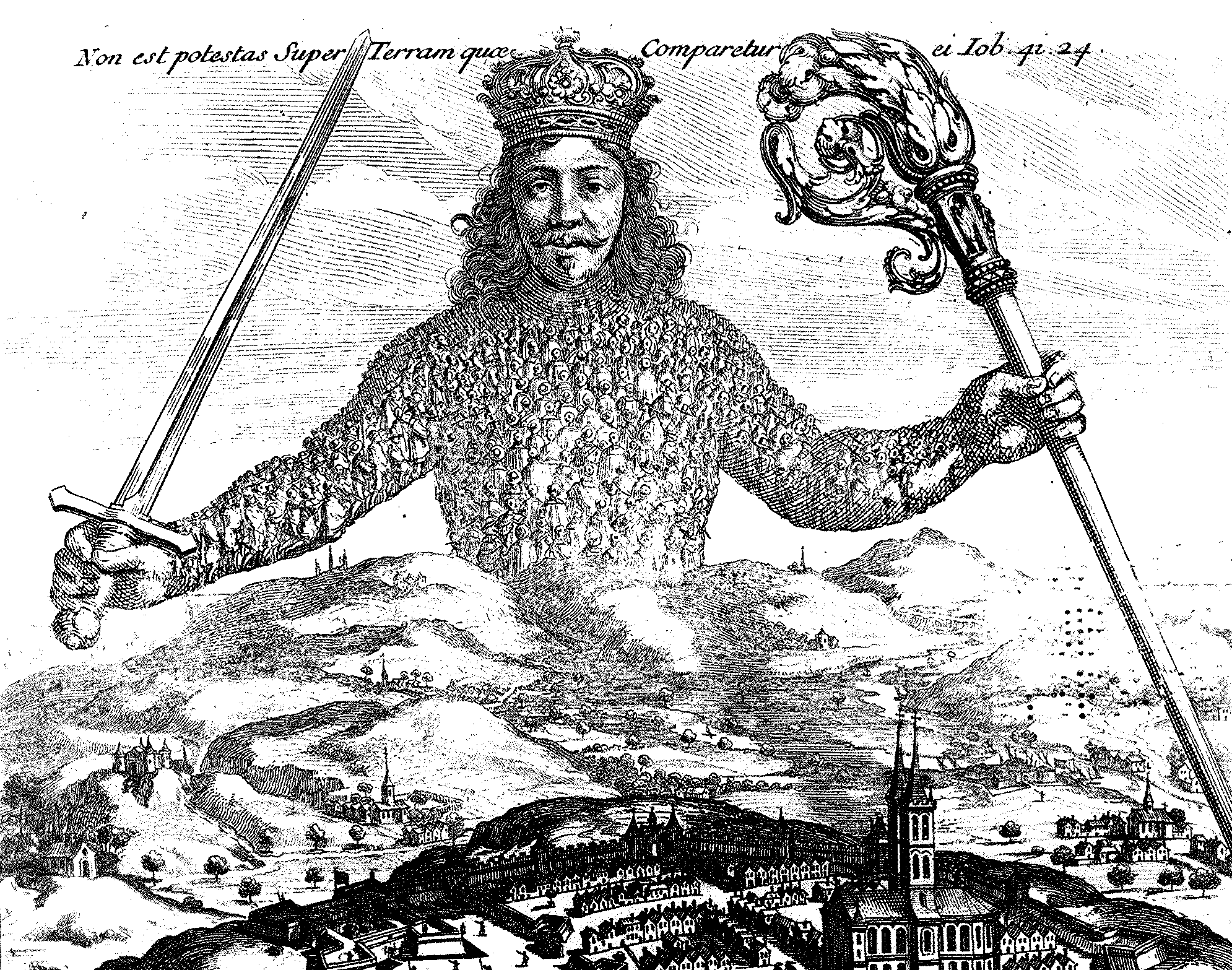 Illustration by Abraham Bosse for the book “Leviathan” writen by Thomas Hobbes (1668)
Illustration by Abraham Bosse for the book “Leviathan” writen by Thomas Hobbes (1668)
Specific ties which create the network are not hidden, even though the myth says that the invisible puppet master pulls the strings. As we can see, it is actually a relatively complex network of many knots with dynamics driven by the interests of specific actors. Companies of this size influence, organise, and determine the lives of elites, the global economy, the everyday life of “small people” or “average users” (as we can define the people today). It is important to describe precisely how and to which part of the network which actors are tied. Once we understand the deep intertwining of the large companies with politics, it is easier to recognise and articulate the support of those forces in the political arena which are pleading for the legal separation of these branches of society.
***
Credits:
Data analysis and data interpretation: Jan Krasni
Data organisation, analysis and visualisation: Vladan Joler
Data collection: Christo and Andrej Petrovski
Thanks to Fieke, Leil, Christo and Claudio from Tactical Tech and Oli, Andrej and Psyho from SHARE Lab for the week of collaborative data collection and investigation that lead to the data set used for this research. Thanks to Kate Maxwell for hints on language and sadistic comments, and Steven Surdiacourt for the help with formulations. Thanks to Jaspal Singh for the challenging comments and the final touch.
–
Share Lab & Tactical Tech

